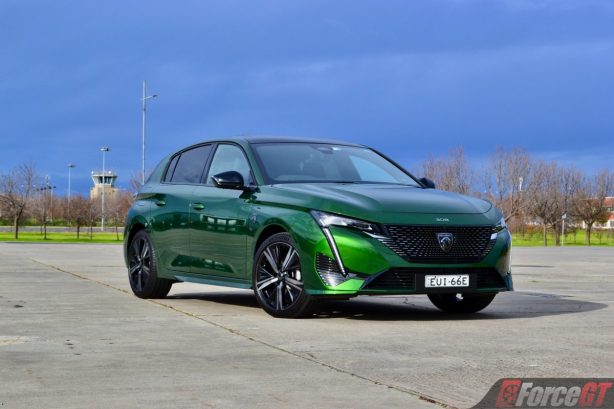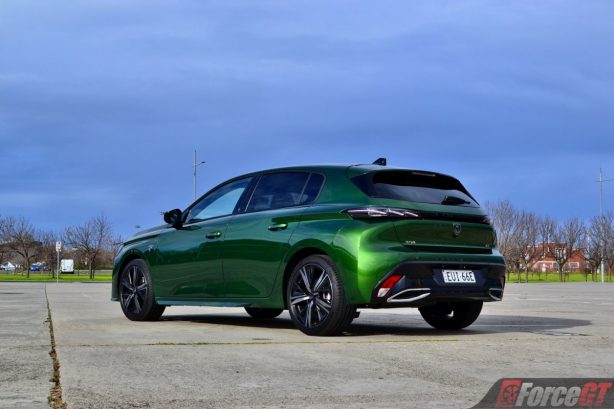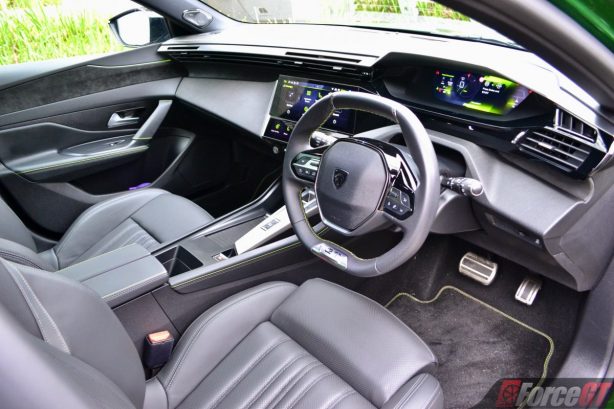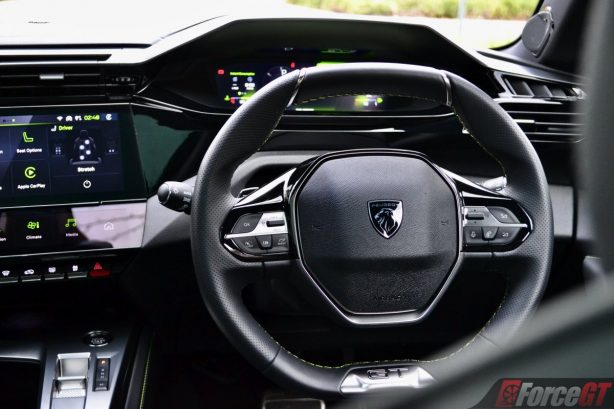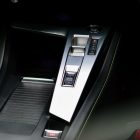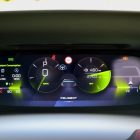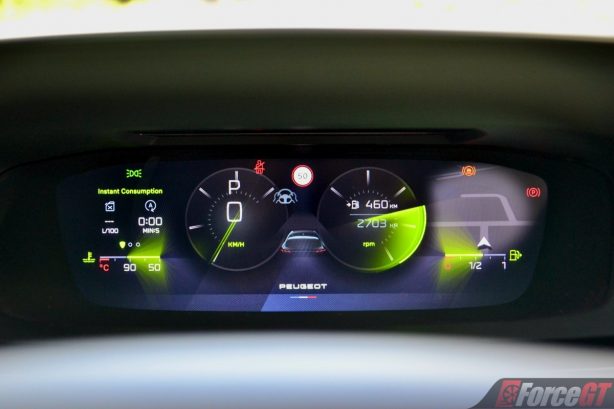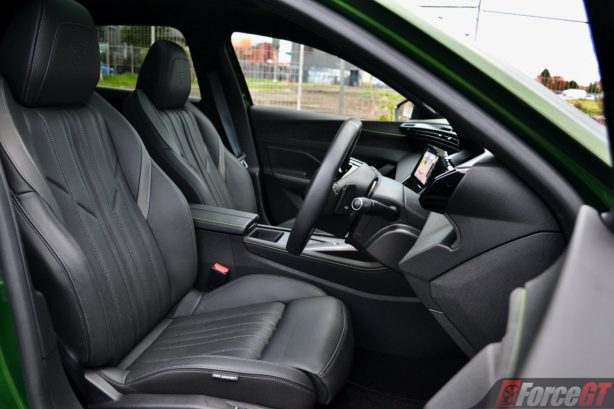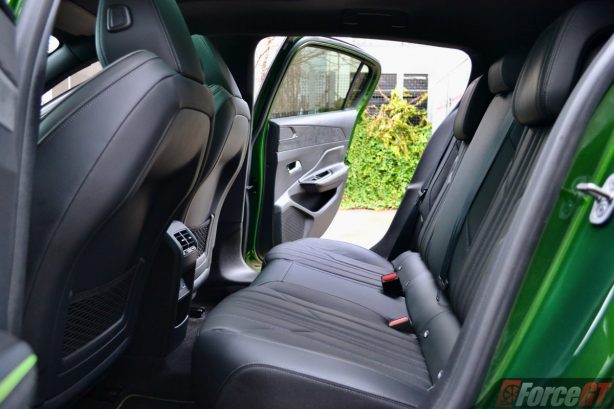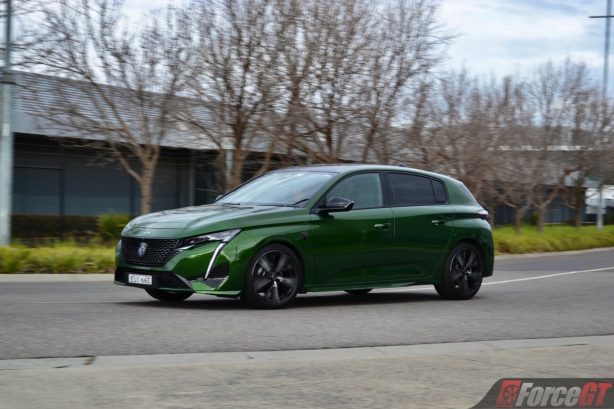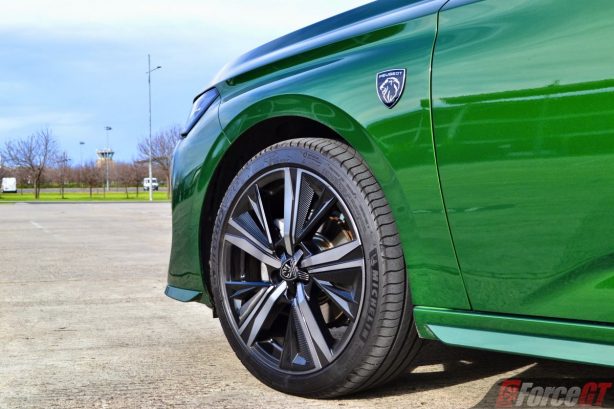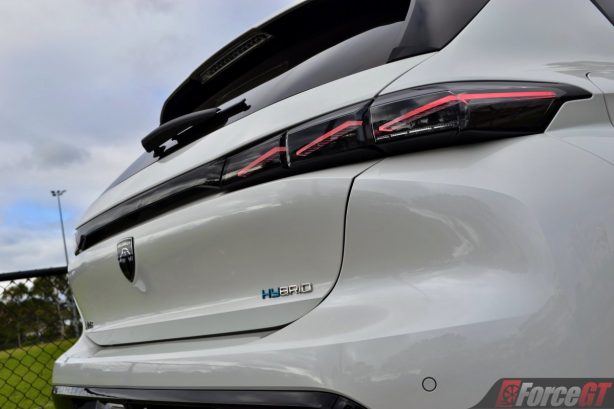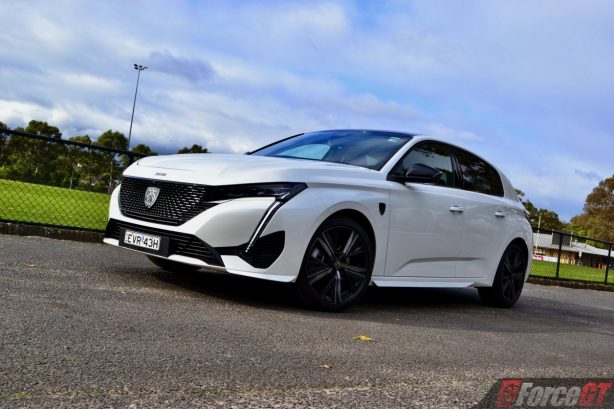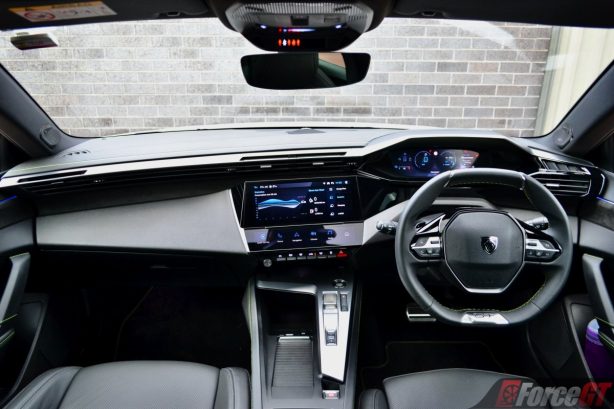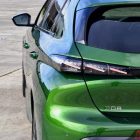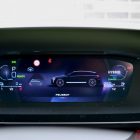The last generation Peugeot 308 was the start of an upmarket push for the French marque. It had eyes on the semi-premium small hatch segment, with an aim to draw buyers away from the Volkswagen Golf and Mazda3.
Now there’s an all-new model to bring that momentum to a new level. Not only is the new 308 gunning for the upper mainstream segment, it’s also advancing on the luxury space encroaching on the territories of the Audi A3 and BMW 1 Series.
It’s reflected by the 308’s pricing which starts at $43,990 for the 308 GT hatch, stretching to $48,990 for the 308 GT Premium hatch like the one on test here. We also drove the 308 GT Sport Plug-in Hybrid (PHEV) hatch which asks for a hefty $64,990. All prices exclude on-road costs.
It’s not just the pricing that spells premium, fortunately, the car itself does, too. The new 308 is an absolute head-turner. The front fascia is instantly recognisable as a Peugeot, having adopted the brand’s signature ‘claw’ LED daytime running lights and assertive grille design that incorporates the new Peugeot emblem.
The confident styling continues through to the sides and rear of the car, where sharp creases and bold lines characterise the styling. Our 308 GT Premium test vehicle is draped in the Olivine Green metallic colour which truly accentuates the design elements.
No doubt, the new 308 is a breath of fresh air in contemporary small car design, one that stands out amongst a sea of derivatively styled models in the segment.
Inside, it’s even more impressive. The feel is premium, the execution is fabulous and the quality is good. The futuristic cabin design pairs exquisite nappa leather and suede upholstery with faux aluminium and deep gloss black trim inserts. There’re also mood lighting strips to set the desired cabin tone. We think this is the best interior yet from Peugeot and one of the best in class.
The quirky i-Cockpit features an instrumentation cluster mounted high up the dashboard and is designed to be viewed from above the steering wheel, not through it. Peugeot says this design eliminates the need for a head-up display and allows the steering to be smaller and sportier.
The digital instrumentation is one of the coolest we have seen. In addition to the main LCD cluster, a second smaller LCD display is embedded in top part of the binnacle housing. Because the display is facing downward, its content is reflected in the foreground of the main display giving a hologram effect. The result is a naturally 3D display with more important information layered in the foreground and closer to the driver’s eye-line. It’s an ingenious design and one that works very well and looks even cooler. It also offers good customisability, including the option of a full map view.
Also part of the i-Cockpit is the high clarity 10.0-inch centre touchscreen that is ultra responsive to the touch. The on-screen menu structure isn’t the most straightforward, but it isn’t too bad thanks to the secondary touch display below the main screen where customisable shortcuts can be set.
Wireless Apple CarPlay and wireless Android Auto are both supported. We tried the former and noticed that the occasional drop off. A little more tweaking is certainly needed to get it to work smoothly. When connected though, audio quality through the Focal 690-watt 10-speaker surround sound system is excellent. A wireless phone charger is fitted so there’s messy cables to worry about.
The seats contour nicely to the body, offering comfortable and supportive seating. The front seats have massaging and heating functions, though only the driver’s seat has electric adjustment.
Storage compartments offered include double cup holders at the front centre console and also in the drop-down rear seat centre arm rest, felt-lined door bins with bottle holders and a glove box. The centre console bin with a centre-splitting double-door opening not only looks premium but is also practical as there isn’t a large pop-up lid to deal with.
While the space up the front is fine, rear seat space is a premium with tight knee and foot room. Rear passengers do get the comfort of rear air vents, however. Further back the boot space has a capacity of 384 litres, on par with class average. Fold the 40:60 split rear seats and the space expands to 1295 litres.
On the safety front, the 308 is comprehensively equipped. Autonomous emergency braking with pedestrian and cyclist detection, blind-spot monitoring, active lane-keep assist, adaptive cruise control, rear cross-traffic alert and speed sign recognition are all fitted as standard. On top of those it has six airbags. However, its ANCAP safety rating is a less-than-perfect four-star, with the test authority noting lower scores in the driver’s chest and lower legs protection.
Non hybrid versions of the 308 are powered by a 1.2-litre 3-cylinder turbocharged petrol engine that develops 96kW @ 5500rpm and 230Nm @ 1750rpm. While the output figure isn’t too shabby for a small hatchback, it’s odd that the 308 isn’t offered with the higher rated version of the same engine found in the GT Sport variant of the Peugeot 2008 small SUV. In that model, the engine makes 114kW and 240Nm, which would be quite nice to have in the 308.
Nonetheless, the 308 does the daily grind just fine with what power and torque it has. But occasionally you just wish it had the higher output engine to deliver the kind of spritely acceleration you’d expect from a sporty hatchback – especially true at this price point.
The mill also isn’t the most refined. Being a 3-cylinder isn’t an excuse as we’ve driven quite a number of smooth 3-potters including, ironically, the Peugeot 2008. This proves that the uprated engine in the 2008 is also more refined.
We aren’t a fan of the auto idle stop/start feature which shuts the engine prematurely as the car rolls to a stop. This means if the conditions permit (e.g. sufficient batter charge level and engine temperature) the engine will always turn off coming to a stop. There’s no way to regulate it with the brake pressure (e.g. light braking keeps engine running). Fortunately this can be turned off if it gets too annoying.
The engine is hooked up to an eight-speed torque converter automatic driving the front wheels. Unlike the gruff engine, the transmission is smooth and picks the right ratio most of the time.
The 308 certainly handles as sportily as it looks. The steering is light and quick, the chassis is taut and body control is sublime. The warm hatch-like dynamics are quite a standout in this class. We can only hope that Peugeot revives the GTI in this generation of 308, as that’s going to be remarkable given how sharp the regular 308 drives.
The 308 PHEV is a more powerful and refined alternative to the non-hybrid 308. For a start, it has a larger engine in the form of a 1.6-litre 4-cylinder turbocharged petrol engine that produces 132kW @ 6000rpm and 250Nm @ 1750rpm. It’s supplemented by an electric motor that is good for 81kW and 320Nm. Combined, the system outputs 165kW and 360Nm.
A multi-plate clutch eight-speed auto is used and drive is sent to the front wheels. With a claimed 0-100km/h acceleration time of 7.5 seconds, the 308 PHEV is over two seconds faster than the regular 308 in the benchmark sprint.
There’s around 50km of quiet and smooth EV range available from a full battery charge before the engine kicks in, at which point the car engages hybrid mode. In this mode the drive seamlessly transitions between the engine and electric motor, or engages both. Coasting and braking recharge the battery and the electric motor moves the car at low speeds. When more power is needed the engine takes over.
The 308 PHEV is not without its drawback. Its not that electrically efficient, meaning it depletes charge quicker than other PHEVs we have sampled. It doesn’t support quick charging either, with a maximum charge rate of just 3.7kW. Using a regular household power socket, it’ll take around 5.5 hours to replenish the battery. Taking it to a charge point, it’ll still need at least 3.5 hours to charge.
The PHEV is also a lot heavier than the non-hybrid model, which inherently blunts the handling a little. But the 308 is not a designated performance car so it’s really not much of an issue.
Both 308 petrol and PHEV variants deliver good ride comfort over varying road surfaces. The cabin is also relatively quiet compared to other more mainstream models in the segment, adding to the premium driving feel. This rings true given how nice the interior of the 308 is. The feel good factor is certainly there when driving the 308.
In terms of fuel economy, after over 500km of driving the regular 308 returned a combined average of 6.5L/100km. Not bad. This is against the rated 5.3L/100km.
We did a mix of EV and hybrid driving in the 308 PHEV over similar distance. At the end of our test period it reported an average of 4.5L/100km, against the claimed 1.4L/100km, proving that the 308 PHEV is still the more economical variant whether or not its driven in full EV mode.
Service interval for the standard 308 is 12 months or 15000km, while for the PHEV it’s 12 months or 20000km.
Verdict
Design & Comfort
Performance & Handling
Quality
Economy
Equipment & Features
OUR SCORE
4.0/5
+ Plus
- Attractive styling
- Premium interior
- Balanced performance
- Well equipped
– Minus
- Pricey
- Petrol engine can do with more power
- PHEV does not support fast-charging
Overall
Price at the higher end of the segment, the latest Peugeot 308 is still somewhat a niche offering and thus has the exclusivity that others don’t. It feels like a premium product and there’s no shortage of cool techs on display. But the petrol variant could do with an uprated powertrain and the PHEV’s hefty sticker price is a tough sell.
2023 Peugeot 308 Pricing and Specification
| Price (Excl. on-road costs): | 308 GT Hatch: $43,990 308 GT Premium Hatch: $48,990 (tested) 308 GT Sport PHEV: $64,990 (tested) |
| Warranty: | 5 years/Unlimited kilometres |
| Country of Origin: | France |
| Service Intervals: | 12 months / 15,000km; 12 months / 20,000km (PHEV) |
| Engine: | Petrol: 1.2-litre turbocharged 3-cylinder petrol 96kW @ 5500rpm / 230Nm @ 1750rpm PHEV: 1.6-litre turbocharged 4-cylinder petrol, electric motor Engine: 132kW @ 6000rpm / 250Nm @ 1750rpm. Electric motor: 81kW, 320Nm Total: 165kW, 360Nm |
| Transmission: | 8-speed automatic |
| Drivetrain: | Front-wheel drive |
| Combined Fuel Consumption (L/100km): | Petrol: Claimed: 5.3/ Tested: 6.5 PHEV: Claimed: 1.4/ Tested: 4.5 |
| RON Rating: | 95 |
| Fuel Capacity (L): | Petrol: 52 PHEV: 40 |
| Body: | 5-door hatch, 5 seats |
| Safety: | 4-star ANCAP, 6 Airbags, ABS, ESC, TCS, EBD, BA, Reversing Camera, 360-degree Surround View Monitor, Blind Spot Detection, Lane Departure Warning, Tyre Pressure Monitoring System, Adaptive Cruise Control |
| Dimensions (L/W/H/W-B) mm: | 4,365/1,859/1,465/2,675 |
| Tare Mass (kg): | Petrol: 1,258 PHEV: 1,611 |
| Towing Capacity (kg): | Petrol: Braked: 1400kg / Unbraked: 680kg PHEV: Braked: 1500kg / Unbraked: 680kg |
| Entertainment: | 10.0-inch colour touchscreen with Satellite Navigation, DAB, Bluetooth, Apple CarPlay, Android Auto, USB, Focal 10-speaker premium audio with subwoofer and amplifier |
 ForceGT.com Car News, Car Reviews, Video Reviews, Tuning and much more.
ForceGT.com Car News, Car Reviews, Video Reviews, Tuning and much more. 